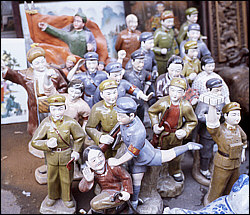| The Voigtländer Bessa-R | |||
|
The Camera Web Links |
|||
|
After using this camera fairly extensively for the past few months, it's time for an update on my "user experience," as we like to say in the world of computers. Things I Like Weight: This is a lightweight camera. I've had a chance to handle a Leica M6, and that camera feels much heavier. The M6 also feel more solid overall, so I guess there is a tradeoff. I think the Bessa-R is a worthwhile compromise – I hope it turns out to be a durable camera. I still don't care much for the ergonomic bump on the back of the camera, but for the most part I don't notice it. I can carry this camera around my neck all day and not have a sore neck and shoulders when I get home. It's one of the reasons I've stopped carrying my older but reliable Nikons as everyday cameras. Size: This camera feels perfect in my hands. Because it has so few controls, it is a joy to operate. No fumbling for power switches or trying to figure out what mode you need to be in. This is back-to-the-basics photography at its best. Controls: I've gotten used to the aperture ring and the slim metal focusing ring. It took a few weeks, but now I have a real feel for it. I still wish the advance lever was ratcheted, but I'll live with it (no other choice). The finger rests naturally on the shutter release, and the thumb sits where it should, perched on the film advance. Changing shutter speeds is a snap, though I still think it's a bit too stiff. Viewfinder: I like the large bright viewfinder and rangefinder patch. I think this camera is easier to focus in low light than most SLRs because of the rangefinder patch. The LED display took a little bit of adjustment, but I can now judge how much over or under the exposure is based on what happens to be lit in the display. Still, I'd like to see some shutter speeds or apertures, if possible. Look: The more I own it, the more I like the overall design of the Bessa-R. It's simple yet elegant and attractive. Nice angles with a traditional look, yet it still manages to be unique. Taken as a package, it feels perfectly balanced. Things I'd Change The short list: I don't have many gripes about the Bessa-R. I would opt for more metal in construction, at the risk of adding some weight and cost. I would like to see stiff metal back, for example. I also would do away with the smooth rubber finish on the back and use the textured finish all around. I treat my cameras with a high level of care, yet the rubber finish continues to accumulate little scuffs, scratches and nose prints. The nose prints come off – I can't say the same for the scratches and some scuff marks. I really like the metal lens cap, and I'm almost positive that I'm going to lose it soon – to the point of paranoia. I know, I should get a tether. I'm thinking of it. I'd like to see shutter speed and/or aperture settings in the display. You spend more time than necessary shifting your eye away from the viewfinder to confirm shutter speed, etc. Judging the Results
What good is a camera, if the photos are disappointing? I've been very pleased with the results. I took this camera and two rolls of Ektachrome to Shanghai on a recent business trip. The slides were sharp, although I felt sometimes a bit low in contrast, which you can adjust on a computer, but not when viewing on a light table or slide projector. However, in other photos, they seem fine. I think there is something else at play. Since 1977, I've used Japanese SLR lenses from Pentax, Nikon and the occasional Vivitar Series 1 zoom. These lenses are extremely contrasty, sometimes excessively. It's very possible that I'm used to seeing these images. The Voigtlander series of lenses need to be judged by themselves. It's difficult to judge photo quality in images that are just 250 pixels wide, but I think they give you an idea of the sharpness you can expect from the Bessa-R. As I said, I'm very pleased with the results, and I think part of it is linked to the camera's ergonomics. If you don't feel comfortable with your camera, you'll spend more time fighting the camera than taking photos.
I've felt at ease with the Bessa-R since Day One. I can lift it to my eye, set the exposure, focus on my subject and compose effortlessly. This final photo (also on Ektachrome) is from Hong Kong. I really like this photo, because it has a liquid feel to it that I can't describe accurately. It's more of a feeling. The Bessa-R performed perfectly.
|
|||



